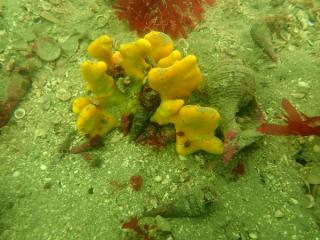
Subtidal Reef Enhancement Block Survey
- Client Name
- Te Ara Tupua (a NZ Transport Agency Waka Kotahi project)
- Location
- Wellington, New Zealand

Challenge
NZ Transport Agency Waka Kotahi is constructing a walking and cycling link to improve transport resilience between Ngā Ūranga, Wellington City and Lower Hutt (Ngā Ūranga ki Pito-One), known as the Te Ara Tupua Alliance project. Restoring and protecting the environment is a key objective for the project and the client devised a nature-based solution for restoring and protecting marine ecosystems.
Partnering with the project delivery team and iwi mana whenua Taranaki Whānui ki te Upoko o te Ika and Ngāti Toa Rangatira, the solution involved building an enhanced subtidal reef habitat including the installation of 56 reef blocks on the seabed from May - September 2024. Of significant scale, each block was 4m long by 4m wide, and 5m tall, weighing approximately 22 tonnes. The client required marine ecological survey expertise to monitor the colonisation of these subtidal reef enhancement blocks.
Solution
SLR has significant marine ecological monitoring expertise in New Zealand across multiple sectors including ecological surveys for aquaculture, ports and coastal infrastructure and offshore industries.
Our marine ecology team is undertaking the marine ecological monitoring involving pre-installation monitoring (baseline assessment) and post-installation monitoring. Our team led the extensive field work to collect the necessary data and employed multiple survey techniques. This involved SCUBA imagery transects and quadrat surveys, baited underwater video imagery collection, drop-down video imagery collection, and sediment core sampling via diver and grab sampling.
The pre-installation monitoring was completed in March 2024 and SLR will conduct the first post-installation survey in early 2025. The data will be used to track the colonisation of artificial subtidal reef enhancement blocks by macroalgae, invertebrates, and fish. SLR will monitor the colonisation of the reef enhancement blocks and adjacent area by epifauna and infauna invertebrates, macroalgae, fish taxa, as well as any invasive or non-native taxa that may occur.
Our client provided a specific scope of services and utilising our expertise, we made multiple suggestions relating to survey design and parameters to be measured. Following these recommendations the client amended some of the planned survey locations and added extra parameters to their analytical suite. In addition, for SCUBA imagery collection, we recommended best practice methods and techniques, which were agreed by the client and executed in the field.
Impact
Monitoring the colonisation of the reef enhancement blocks is a long-term project, spanning a six-year programme of works. Long-term monitoring will assess the efficacy of the use of reef enhancement blocks as subtidal reef habitat for macroalgae, invertebrates, and fish. Ultimately the project will contribute towards enhancing the biodiversity in Wellington Harbour.
This project is the first of its kind in New Zealand and will provide valuable data and learnings on a nature-based solution that has been adopted to compensate for the effects of coastal infrastructure development.





